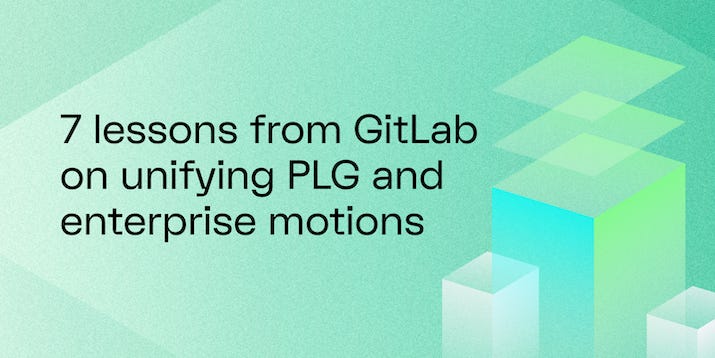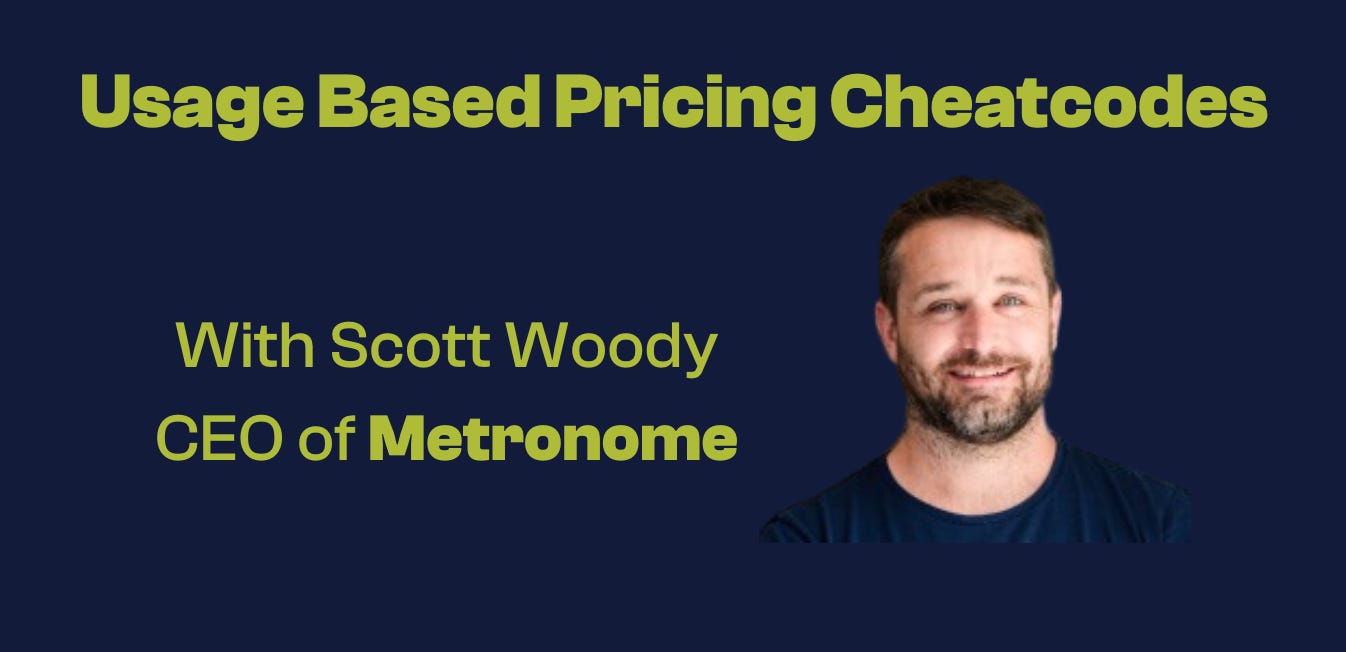Cheatcodes for Usage-Based Pricing (with Scott Woody)
Plus: Win a free Pricing Power Assessment.
Welcome back to Good Better Best!
If you missed it this week, we launched a new service with Ulrik and the team at Willingness to Pay called the Pricing Power Assessment.
The assessment combines deep financial analysis with qualitative interviews to do 3 things:
Identify if you have pricing and packaging potential
Quantify the revenue opportunity (e.g., 50% uplift)
Prescribe next steps to take advantage
If you are a B2B SaaS company doing $5M+ in ARR (or growing really fast), and looking for an outside perspective on pricing and packaging — this could be for you.
As part of the launch, we’re giving away a free assessment to one lucky SaaS company. Apply now, and stay tuned! We’ll announce the winner on July 31st.
On to today’s post.
How GitLab unified PLG and enterprise with one price book
In a recent podcast episode, GitLab's Justin Farris revealed how they scale from free users to Fortune 500 customers with transparent pricing that works for everyone. Learn their blueprint for treating pricing as a product feature, aligning PLG and sales teams around shared metrics, and using buyer-based tiers instead of traditional good-better-best models in this blog post.
A few weeks back, we gathered a small group of pricing leaders for an impromptu workshop with Metronome CEO, Scott Woody.
At Metronome, Scott and his team are pushing UBP into new frontiers with some of the most innovative companies in AI (e.g., OpenAI, AssemblyAI).
Below, I’ve summarized the key questions that were asked during the session, and Scott’s answers below.
PS. We’re doing another workshop with Scott in August. Shoot me a DM if you’d like to attend.
1️⃣ How do you forecast usage in the early stages of a product?
It depends on your company size and maturity of the product:
If you’re early-stage:
YOLO with pay-as-you-go: Launch with transparent PayGo pricing and use the first months to learn.
Free credits: Seed with a generous credit (e.g. $100) to observe behavior and guide spend expectations.
Set expectations + guardrails: Let customers self-regulate with spend caps and visibility into usage.
Have a pricing thesis: Pick your target price point first (e.g. $500/month), then shape your product and pricing mechanics to hit that.
If you're at scale:
Run price experiments: Segment your customer base and test different usage prices (e.g. $1 vs. $2 per unit).
Measure elasticity: Use behavior across cohorts to dial in the right price-volume curve.
Bonus concept: Design pricing like a car—you’re either building a Porsche, a Civic, or a Tesla. Know your target price and build backwards from there.
2️⃣ How do you handle unexpected usage spikes with usage-based pricing?
Guardrails, transparency, and rate limiting.
Unexpected usage spikes can erode customer trust and burn your margins—especially in AI or infra products with high variable costs. Scott recommends:
Giving customers control: Let them set usage budgets or soft caps.
Offering free credits upfront: This helps customers understand expected spend before real billing kicks in.
Building guardrails into the product: Notifications, caps, or rate limits prevent accidental overspend.
Protecting against fraud: High-usage systems often become fraud targets; rate limits and spend ceilings help defend against abuse.
Taking the blame: If a spike happens and a customer racks up an unpayable bill, it’s not a finance issue, it’s a product failure. Don’t expect to collect it.
Example: OpenAI’s budget settings let users define limits to avoid surprise bills. Without these guardrails, a customer can accidentally rack up thousands in charges. Such incidents must be treated as system failures, and fixed as soon as possible.
3️⃣ What are the operational requirements and constraints of incorporating usage-based pricing?
Usage-based pricing is a company-wide systems problem. Here’s what it touches:
🔧 CRO / Sales:
Enablement: Reps must shift from “selling before the contract” to driving usage after the contract.
Compensation: Quotas and incentives need to align with consumption and retention, not just bookings.
Team structure: Many companies hybridize AEs and AMs, or create new roles altogether.
📊 Finance:
Forecasting flips: Bookings become less relevant; Net Revenue Retention (NRR) and usage forecasts become critical.
Data fluency: Finance teams need regression models and daily account-level forecasts.
Cash flow changes: Less predictability unless you use upfront credit purchases.
🧱 Product:
Telemetry: Teams need detailed usage tracking.
Revenue impact: Every feature change can impact revenue (positively or negatively).
Customer experience: Must build in cost visibility, alerts, audit logs, etc.
Pro tip: Treat pricing changes like a product launch. If you’d never launch a half-baked feature, don’t launch a half-baked pricing model.
4️⃣ What are the pros/cons of usage-based pricing vs. a credit model (upfront commitment)?
✅ Credits Model Pros:
Feels like SaaS (upfront commitment, predictability).
Easier for procurement (similar to existing buying workflows).
Smoother revenue recognition (despite still being usage-driven).
Reduces overage anxiety.
❌ Credits Model Cons:
Still requires full product and billing investments to enable usage tracking and controls.
Requires rules for rollover, overspend, and top-up (can be complex).
✅ Usage-Based Pricing Pros:
Cleanly aligns value with usage.
Easier to trial and ramp.
Preferred in AI-heavy or infra products.
❌ Usage-Based Pricing Cons:
Scary for finance and procurement.
Harder to forecast and sell.
Requires mature product telemetry and user education.
Best practice: Start with credits. Scott sees most successful transitions begin with an upfront credit buy + a usage-based add-on, led by a tiger team focused on reinventing GTM and product around the new commercial model.
5️⃣ How do you mitigate the complexity of usage-based pricing in large B2B deals (especially with procurement)?
Usage pricing used to be a liability in procurement. It’s now becoming a competitive advantage if your reps are trained right.
What’s changed:
Buyers are used to cloud infrastructure pricing (AWS, GCP, Azure).
Even conservative industries (like banks) are asking for consumption-based deals.
AI tailwinds make usage feel fair—you pay for what you use, and the work gets done for you.
How to make it work:
Use credit-based contracts: Large upfront purchases offer budget predictability.
Offer rollover and pull-forward options: Avoid punishing customers for under/overuse.
Equip champions to explain value: Don’t expect procurement to figure it out—give your buyer the tools.
Train sellers on new playbooks: This is a different kind of sales cycle; don’t send in legacy SaaS reps unarmed.
Tactical tip: Most friction isn’t with procurement—it’s with your sellers. Poor sales enablement is the #1 blocker to usage adoption in the enterprise.
🎁 Bonus: What are some examples where usage-based pricing has failed, and why?
Most failures are execution failures, not demand-side failures. Key reasons:
Poor value communication: Companies fail to clearly articulate what users are paying for.
Misaligned product: Usage pricing demands visibility, predictability, and control. If your product doesn’t provide these, the pricing model won’t stick.
Marketing mismatch: Framing usage as an "outcome" is trendy, but if you can’t justify it, customers will push back.
Underinvestment in billing experience: Seat-based SaaS gets away with bare-bones billing portals. Usage-based doesn’t.
Example: Cursor recently had to roll back its pricing change even though the new pricing was cheaper, because the product lacked the controls and clarity needed to make usage pricing work.
Thanks again to Scott for sharing his wisdom! And to the crew who joined and asked such thoughtful questions. If you’re working on usage-based pricing, and would like to join the next workshop — just hit reply or DM me on LinkedIn.
How we can help when you’re ready
PricingSaaS Community: Join the free PricingSaaS Community to get quick answers from experts, real-time pricing data, and access to exclusive events.
PricingSaaS Index: Check out the PricingSaaS Index to track competitors, scroll pricing histories, and create a swipe file of pricing pages for inspiration.
Free Advisory Session: Need a sounding board? Book a 30-minute session. No sales pitch. We’ll provide honest feedback and steer you in the right direction.



